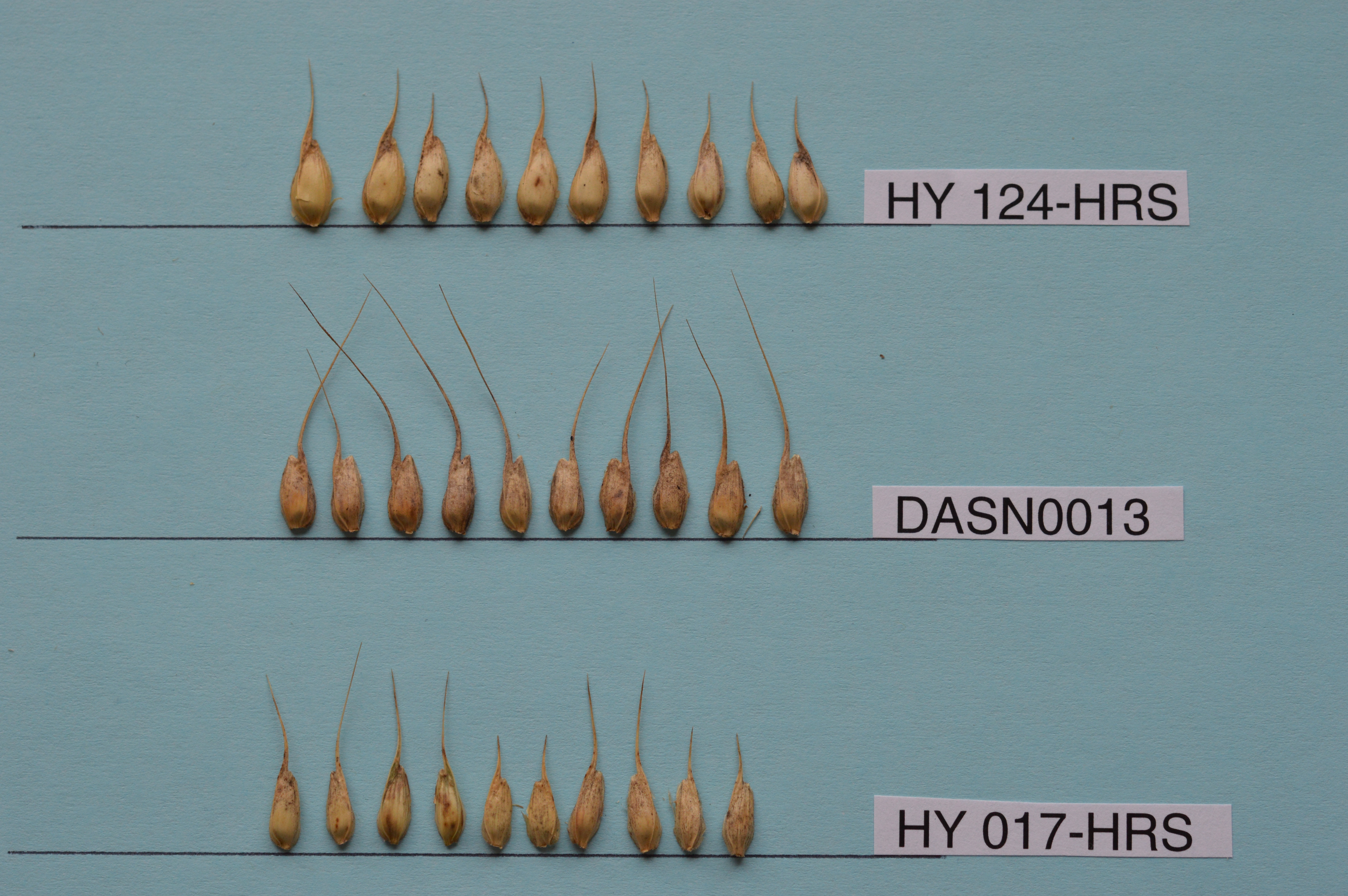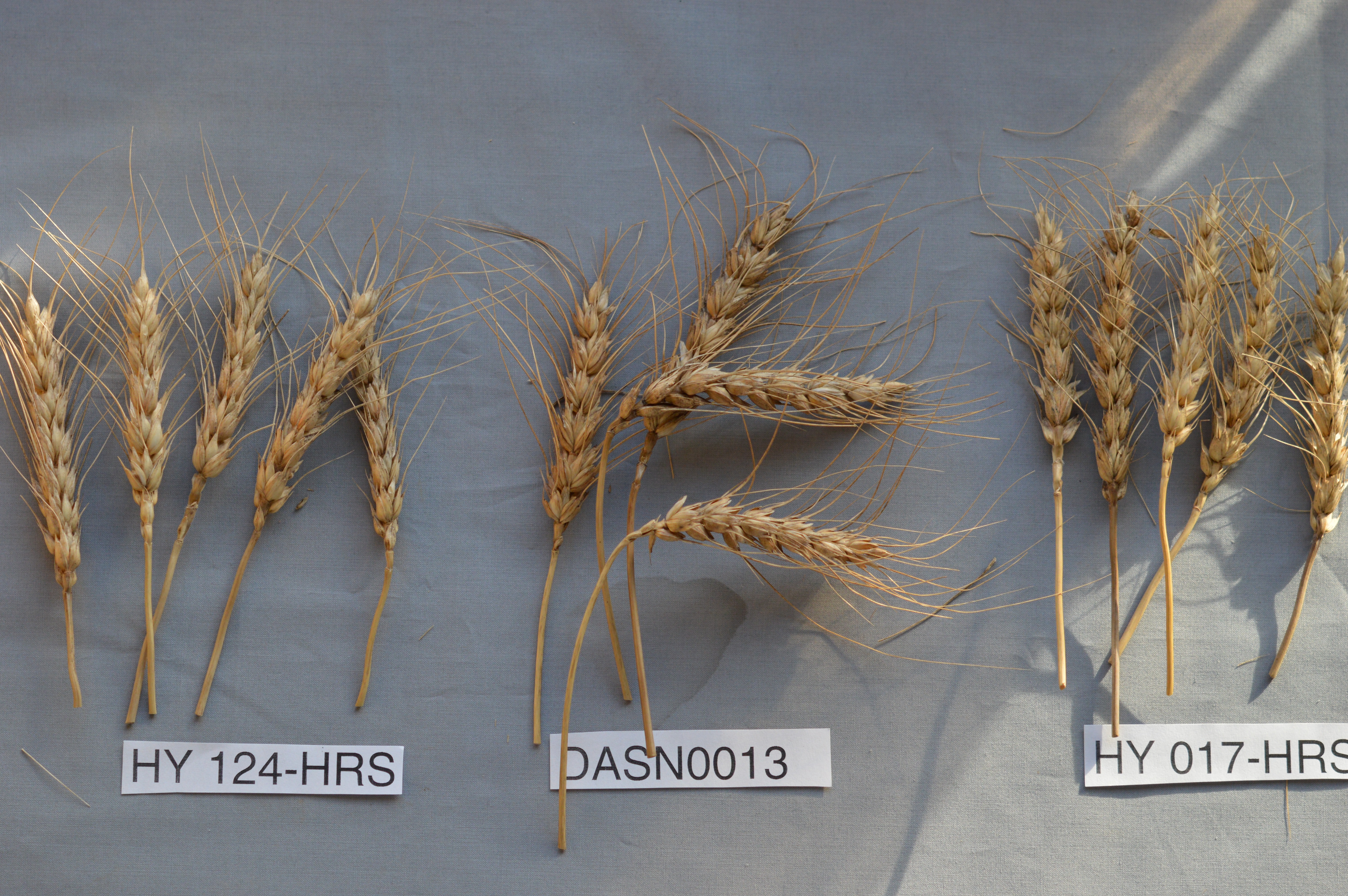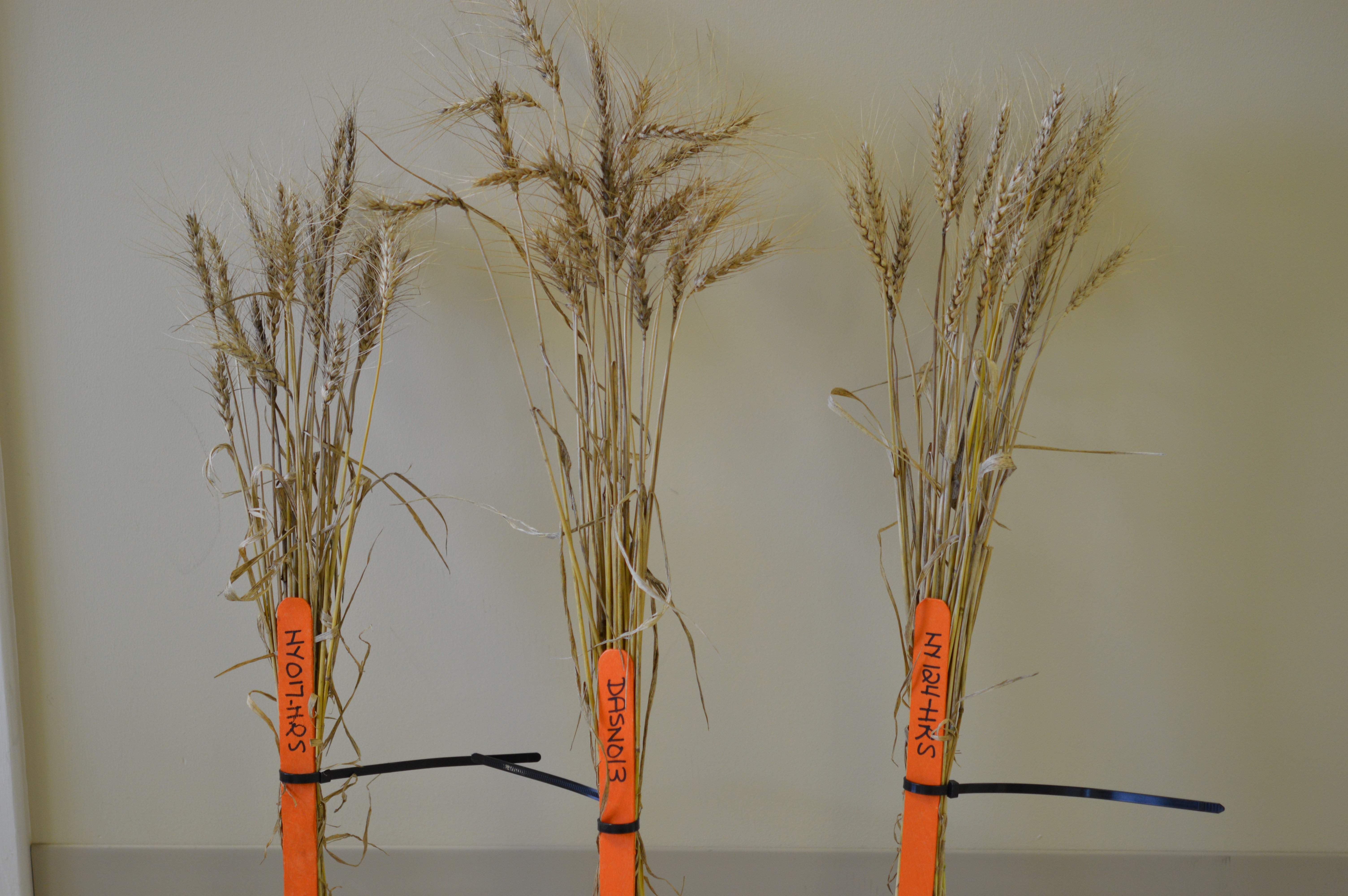DASN0013
| Denomination: | 'DASN0013' |
|---|---|
| Botanical Name: | Triticum aestivum |
| Applicant/Holder: |
Agrigenetics, Inc. 9330 Zionsville Road Indianapolis, Indiana 46268-1054 United States of America |
| Breeder: |
Mark Etienne, DOW AgroSciences (A Division of Dow AgroSciences, Inc.), St. Mary's, Ontario |
| Agent in Canada: |
DOW AgroSciences (A Division of Dow AgroSciences, Inc.) 7061 Cobble Hills Road St. Mary's, Ontario N4X 1C7 Canada Tel: 519-333-2775 |
| Application Date: | 2014-05-29(priority claimed) |
| Application Number: | 14-8340 |
| Protective direction granted: | 2014-05-29 |
| Grant of Rights Date: | 2016-07-28 |
| Certificate Number: | 5295 |
| Date rights revoked: | 2017-07-28 |
Variety Description
Varieties used for comparison: 'HY124-HRS' and 'HY017-HRS'
Summary: At the 5 to 9 tiller stage, the growth habit of 'DASN0013' is semi-erect whereas it is erect for 'HY017-HRS'. The flag leaf of 'DASN0013' is longer than that of 'HY124-HRS'. The frequency of plants with recurved flag leaves is low to medium on 'DASN0013' and very low on 'HY017-HRS'. The intensity of anthocyanin colouration of the flag leaf auricles of 'DASN0013' is strong whereas it is weak for 'HY124-HRS' and medium for 'HY017-HRS'. 'DASN0013' is taller than 'HY017-HRS'. At maturity, the curvature of the culm neck of 'DASN0013' is weak whereas it is strongly to very strongly curved for 'HY124-HRS' and strongly curved for 'HY017-HRS'. The spike density of 'DASN0013' is lax whereas it is medium for 'HY124-HRS'. At maturity, the spike attitude of 'DASN0013' is nodding whereas it is erect for 'HY124-HRS' and inclined for 'HY017-HRS'. The spike colour of 'DASN0013' is brown whereas it is white for both reference varieties. The shape of the shoulder of the lower glume of 'DASN0013' is elevated whereas it is slightly sloping for 'HY124-HRS'. The beak of the lemma of 'DASN0013' is slightly curved whereas it is moderately to strongly curved on 'HY017-HRS'.
Description:
PLANT: hard red spring type, semi-erect growth habit at the 5 to 9 tiller stage, low to medium frequency of plants with recurved flag leaves, heading is early, matures early to mid-season
SEEDLING: absent or very weak intensity of anthocyanin colouration of coleoptile, medium density of pubescence on lower leaf sheaths and blades
FLAG LEAF: strong intensity of anthocyanin colouration of auricles, medium to strong glaucosity of sheath, glabrous blade and sheath
CULM: weak glaucosity, weak curvature of neck
SPIKE: medium to strong glaucosity, tapering to parallel-sided shape, lax density, brown at maturity, nodding attitude at maturity, sparse to medium density of hairiness on convex surface of apical rachis segment
AWNS: short in relation to length of spike, light brown at maturity, spreading attitude
LOWER GLUME: medium length and width, weak to medium density of pubescence, medium extent of internal hairs
LOWER GLUME SHOULDER: medium width, elevated
LOWER GLUME BEAK: long, strongly curved
LOWEST LEMMA: slightly curved beak shape
STRAW: thin pith in cross section, no anthocyanin colouration at maturity
KERNEL: light to medium red, medium to large size, long, midwide to wide, elliptical, rounded cheek, medium length brush hairs, narrow width and mid-deep crease
GERM: midsize to large, oval shape
BREAD MAKING QUALITY: fair
DISEASE REACTION: resistant to Glume blotch (Septoria nodorum), Powdery mildew (Erysiphe graminis f. sp. tritici), Leaf rust (Puccinia triticina) and Stem rust (Puccinia graminis f. sp. tritici); moderately resistant to moderately susceptible to Septoria tritici blotch (Septoria tritici) and Fusarium head blight (Fusarium graminearum, Fusarium species; based on inoculation trials conducted at the Nairn Research Facility in Ailsa Craig, Ontario in 2013); moderately susceptible to Barley Yellow Dwarf virus
Origin & Breeding History: 'DASN0013' (experimental designation 'SW239-018') is derived from the cross between 'AW571' / 'Sable' made in the lab at the Nairn Research Facility, Ailsa Craig, Ontario in 2005-2006. The F1 seed was planted in the lab in 2006 and was doubled using the doubled haploid (maize pollinated) method. The F2 was planted as a single row in the nursery in the spring of 2007 and was selected for its general appearance and disease reaction. 'DASN0013' ('SW239-018') was entered into a 2-replicate trial in the spring of 2008 and subsequent yield evaluations through 2010. 'DASN0013' was tested for two years in the Orthogonal Hard Red Spring Wheat Trial (Ontario Cereal Crop Committee) during the 2011 and 2012 growing seasons and was supported for registration in January 2013.
Tests & Trials: The comparative trials for 'DASN0013' were conducted during the 2013 and 2014 growing seasons at the Nairn Research Facility, Ailsa Craig, Ontario. Plot size was 4.14 metres squared and consisted of 6 rows. The row length was 3.0 metres with 18 cm spacing between rows. There were 4 replicates in an RCB Design. Measured characteristics were based on 20 measurements per variety per year.
Comparison tables for 'DASN0013' with reference varieties 'HY124-HRS' and 'HY017-HRS'
Flag leaf length (cm)
| 'DASN0013' | 'HY124-HRS' | 'HY017-HRS' | |
|---|---|---|---|
| mean 2013 | 23.5 | 18.2 | 22.9 |
| std. deviation 2013 | 2.8 | 2.4 | 2.8 |
| mean 2014 | 20.9 | 16.3 | 20.1 |
| std. deviation 2014 | 2.1 | 1.7 | 2.6 |
Plant height (including awns) (cm)
| 'DASN0013' | 'HY124-HRS' | 'HY017-HRS' | |
|---|---|---|---|
| mean 2013 | 76.2 | 73.9 | 65.6 |
| std. deviation 2013 | 4.1 | 3.5 | 4.0 |
| mean 2014 | 68.5 | 66.4 | 60.4 |
| std. deviation 2014 | 3.7 | 3.6 | 4.2 |
Days to heading
| 'DASN0013' | 'HY124-HRS' | 'HY017-HRS' | |
|---|---|---|---|
| mean Julian days 2013 | 185 | 190 | 188 |
| mean Julian days 2014 | 179 | 184 | 182 |
Click on image for larger view

Wheat: 'DASN0013' (centre) with reference varieties, 'HY124-HRS' (top) and 'HY017-HRS' (bottom)
Click on image for larger view

Wheat: 'DASN0013' (centre) with reference varieties, 'HY124-HRS' (left) and 'HY017-HRS' (right)
Click on image for larger view

Wheat: 'DASN0013' (centre) with reference varieties, 'HY017-HRS' (left) and 'HY124-HRS' (right)
- Date modified: